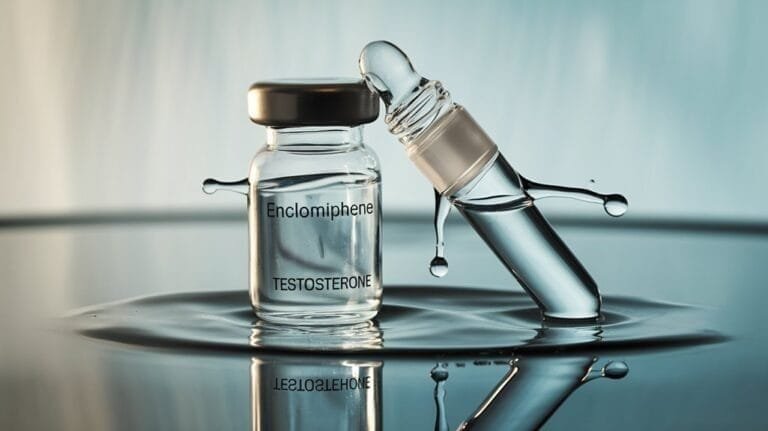When comparing testosterone therapy and enclomiphene, you'll find distinct mechanisms at work. Testosterone injections provide rapid hormonal increases but can suppress natural production and affect fertility. Enclomiphene, on the other hand, enhances your body's own testosterone production while preserving testicular function, making it a suitable choice for maintaining fertility. While both treatments can improve well-being, the long-term implications and side effects differ considerably. Understanding these nuances can guide your decision on the best approach for your health needs.
Key Takeaways
- Testosterone therapy provides rapid symptom relief but may lead to dependency and fluctuating testosterone levels, risking sperm suppression.
- Enclomiphene promotes natural testosterone production, enhancing spermatogenesis while preserving testicular function and fertility.
- Testosterone injections have a higher risk of serious side effects like heart attacks, while enclomiphene typically has milder, more manageable side effects.
- Enclomiphene is administered orally, offering convenience compared to testosterone injections, making it appealing for many users.
- Treatment choice between the two therapies should consider personal priorities like fertility preservation and the urgency of alleviating low testosterone symptoms.
Mechanism of Action: Understanding Enclomiphene and Testosterone Therapy
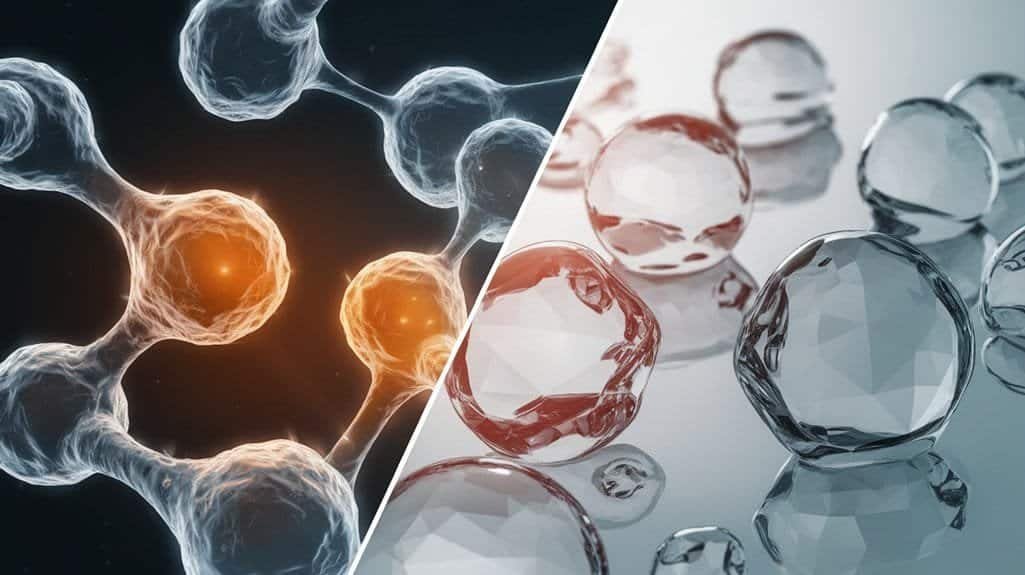
The mechanisms of action for testosterone and enclomiphene highlight their distinct approaches to influencing hormonal balance.
Testosterone binding primarily occurs through direct interaction with androgen receptors or conversion to dihydrotestosterone (DHT), enhancing androgenic effects at the cellular level. This binding cascade triggers gene transcription, impacting various tissues. Testosterone cypionate's slower release rate post-injection allows for more stable serum testosterone levels over time.
Conversely, enclomiphene modulation acts through selective estrogen receptor activity. By blocking estrogen's inhibition on the hypothalamus, enclomiphene stimulates the release of luteinizing hormone (LH) and follicle-stimulating hormone (FSH), thereby promoting endogenous testosterone production.
Unlike testosterone, enclomiphene doesn't affect androgen receptors directly but instead revives the hormonal feedback loop essential for natural testosterone synthesis.
Understanding these mechanisms illuminates the respective roles of testosterone and enclomiphene in therapeutic settings.
Efficacy in Raising Testosterone Levels
When comparing enclomiphene and testosterone therapy, understanding their effects on natural testosterone production is essential. Enclomiphene promotes your body's own testosterone synthesis, potentially leading to more stable hormonal levels. In contrast, testosterone therapy can result in a more rapid increase in testosterone but may carry different implications for long-term hormone regulation. Importantly, enclomiphene has been shown to offer a safer alternative with lower adverse event rates compared to clomiphene.
Natural Testosterone Production
Natural testosterone production hinges on various dietary and lifestyle factors that can effectively raise testosterone levels.
Implementing lifestyle modifications, like strength training, has shown greater efficacy compared to purely cardio routines. For dietary strategies, it's essential to consume adequate protein from sources such as lean meats and eggs, aiming for 5 to 6 ounces daily to prevent deficiencies that can bind testosterone. Additionally, incorporating onions and garlic may enhance sperm production and testosterone levels.
Incorporating foods high in vitamin D, magnesium, and zinc—like fatty fish, leafy greens, and nuts—can further enhance production. Moderation in alcohol consumption and ensuring 7 to 8 hours of sleep each night are key practices that maintain hormone balance.
Avoiding processed foods also supports overall health, thereby facilitating natural testosterone production.
Rapid Testosterone Increase
Although options for raising testosterone levels exist, their efficacy and speed of action differ considerably. Here's a quick comparison:
- Testosterone Replacement Therapy (TRT) provides an immediate increase, ideal for hypogonadism.
- TRT's therapeutic benefits include improvement in libido, energy, and muscle mass, but it doesn't stimulate natural testosterone production.
- Enclomiphene can raise testosterone within 14 days by promoting natural hormone production, which may align better with those seeking less invasive treatment options.
- Although Enclomiphene requires multiple cycles for best results, it offers a more favorable safety profile regarding sperm production.
These factors make it essential to weigh your options thoughtfully, as both approaches have distinct advantages and implications for long-term health.
Fertility Considerations: Enclomiphene vs. Testosterone Replacement Therapy
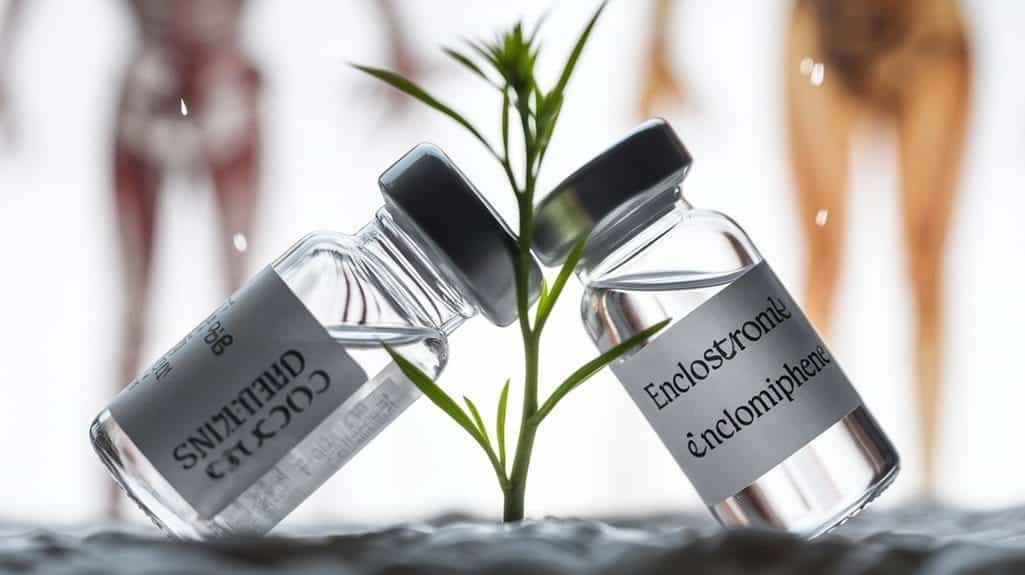
When considering fertility, it's essential to evaluate how enclomiphene and testosterone replacement therapy (TRT) impact sperm production and hormonal balance.
Enclomiphene preserves testicular function and maintains natural testosterone levels, ensuring continuous sperm production.
In contrast, TRT can reduce sperm count and disrupt the hormonal equilibrium necessary for fertility, making it less suitable for those concerned about conception.
Sperm Production Preservation
Sperm production preservation is essential for men considering treatment options for low testosterone, as the choice between enclomiphene and testosterone replacement therapy (TRT) greatly impacts fertility.
Here are key considerations:
- Enclomiphene stimulates LH and FSH release, enhancing spermatogenesis.
- TRT can suppress natural sperm production, leading to oligospermia.
- Clinical trials show enclomiphene maintains baseline sperm counts, unlike testosterone gel.
- Enclomiphene preserves testicular function, promoting optimal sperm health.
Hormonal Balance Maintenance
Deciding between enclomiphene and testosterone replacement therapy (TRT) involves careful consideration of hormonal balance maintenance, particularly in the context of fertility. Enclomiphene functions as a selective estrogen receptor modulator, enhancing gonadotropin release and promoting natural testosterone production.
This mechanism minimizes hormonal fluctuations and supports long-term endocrine health without the risk of exogenous testosterone dependency. In contrast, TRT can disrupt the body's natural hormone production, potentially leading to testicular atrophy and hormonal imbalances.
Enclomiphene preserves testicular function and size, ensuring the body maintains its intrinsic hormonal mechanisms, which is essential for overall well-being and fertility. Evaluating these factors is important for those prioritizing hormonal balance while considering fertility outcomes.
Fertility Impact Assessment
How do enclomiphene and testosterone replacement therapy (TRT) stack up in relation to fertility outcomes? Understanding their effects can greatly shape your fertility options:
- Enclomiphene stimulates LH and FSH, enhancing spermatogenesis without suppressing sperm health.
- TRT reduces sperm production by disrupting LH and FSH levels, often leading to oligospermia.
- Enclomiphene maintains normal semen parameters even in men with hypogonadism.
- Complications from TRT can cause testicular atrophy, though fertility issues are generally reversible.
Side Effects and Adverse Events
When considering testosterone and enclomiphene, it's crucial to understand their respective side effects and potential adverse events.
The side effects comparison reveals that testosterone therapy has a higher prevalence of serious adverse events, such as heart attacks and strokes. Common testosterone side effects include acne, anxiety, and mood swings, as well as severe complications like blood clots and prostate issues.
Conversely, enclomiphene typically has milder side effects, including headaches and increased libido, with no considerable reports of severe cardiovascular or liver damage.
Given testosterone's potential for irreversible changes and a notably higher rate of adverse event reports to the FDA, choosing between these therapies requires a thorough assessment of their side effect profiles and potential risks.
Long-Term Use and Safety of Enclomiphene
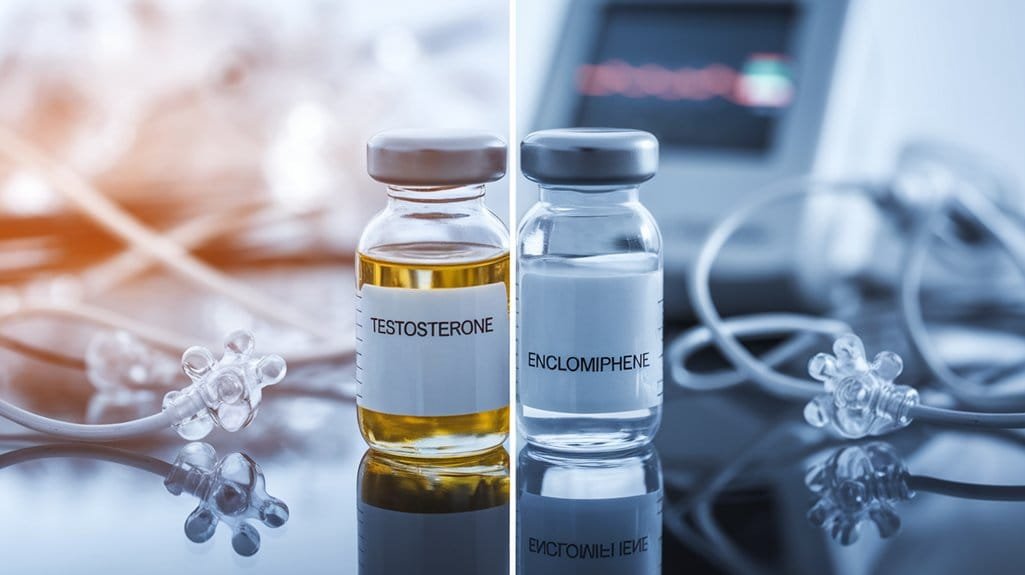
Long-term use of enclomiphene therapy necessitates careful evaluation of safety and efficacy, particularly given the differing side effect profiles highlighted previously. Engaging in long-term monitoring and safety evaluations is significant.
Here are four key factors to reflect upon:
- Regular assessments of hormone levels, particularly testosterone and estrogen, are essential.
- Monitoring lipid profiles and cardiovascular risk factors helps evaluate potential health impacts.
- Hematocrit and prostate-specific antigen (PSA) levels should also be diligently tracked to confirm safety.
- Be aware of increased estrogen levels, as they may cause side effects like gynecomastia.
Although enclomiphene appears generally well-tolerated, ongoing research is necessary to affirm its long-term safety and efficacy.
Individual Circumstances: Choosing Between Enclomiphene and TRT
Given the varied health profiles and personal goals of individuals, choosing between enclomiphene and testosterone replacement therapy (TRT) requires careful evaluation of several key factors.
If preserving testicular function and fertility are personal priorities, enclomiphene may be more suitable. On the other hand, those seeking immediate relief from low testosterone symptoms might prefer TRT for its rapid results.
Lifestyle preferences also play a role; enclomiphene's oral administration is often more convenient compared to the various methods associated with TRT.
It's crucial to reflect on the long-term implications of each treatment, including side effects and hormonal balance.
Ultimately, reviewing your unique situation in consultation with a healthcare professional will lead to the best decision tailored to your individual health needs.
Comparing Natural Testosterone Production With Exogenous Hormone Therapy
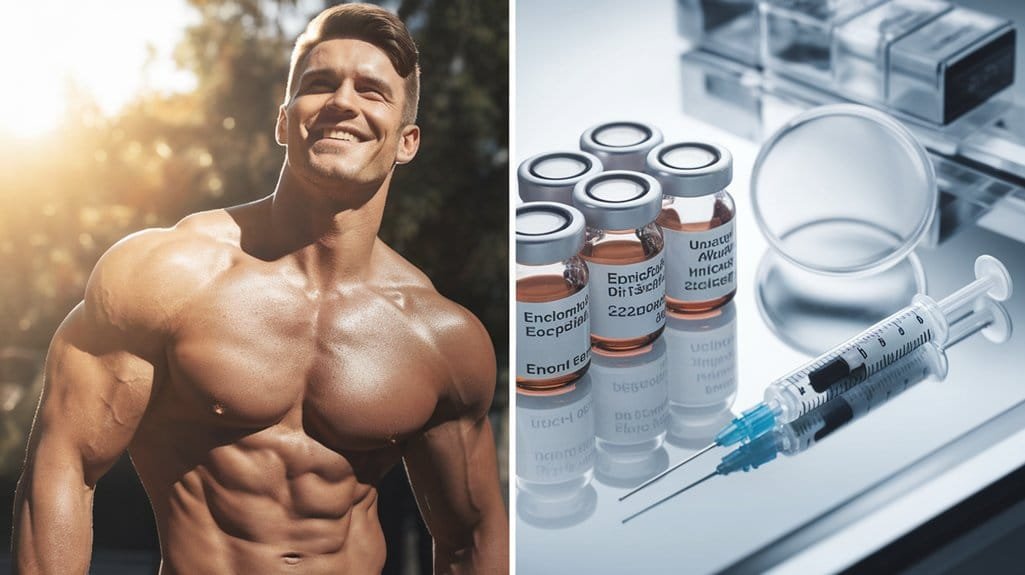
The choice between enclomiphene and testosterone injections impacts not just immediate results but also the underlying mechanisms of testosterone production.
Understanding these differences is essential for ideal treatment.
- Natural Production: Enclomiphene stimulates endogenous testosterone production, preserving your hormonal pathways.
- Immediate Effects: Testosterone injections provide rapid symptom relief but risk fluctuating levels between doses.
- Sperm Preservation: Enclomiphene maintains sperm production, while injections may suppress it due to negative feedback mechanisms.
- Dependence Risk: Relying on injections may create a dependency, whereas enclomiphene encourages self-sustaining testosterone benefits.
Impact on Overall Well-Being and Quality of Life
While both enclomiphene and testosterone injections can enhance overall well-being, their distinct impacts on quality of life reveal critical differences.
Enclomiphene promotes notable quality enhancement through increased energy levels and improved mood, while testosterone therapy supports lean muscle gain and better metabolism.
You may find enclomiphene beneficial for cognitive clarity and sociability, leading to a more favorable social life.
Testosterone's effects on libido and erectile function also contribute to overall wellness.
Importantly, enclomiphene carries a lower rate of side effects compared to testosterone, reducing the risk of complications and preserving fertility.
Ultimately, evaluating your goals and preferences is essential in choosing the therapy that best aligns with your pursuit of enhanced quality of life.
Frequently Asked Questions
How Quickly Do Enclomiphene and TRT Raise Testosterone Levels?
Enclomiphene efficacy generally raises testosterone levels noticeably within two weeks, while TRT comparison shows near-immediate effects, often elevating levels in days. Both achieve significant increases by six weeks but differ in onset and mechanisms.
Can Enclomiphene Be Used With Other Medications or Supplements?
You should definitely consider enclomiphene interactions before combining it with other medications or supplements. Adhering to supplementation guidelines is essential to avoid adverse effects, ensuring you maintain safety and effectiveness in your treatment approach.
What Lifestyle Changes Can Enhance Testosterone Levels Alongside Treatment?
To enhance testosterone levels, prioritize dietary changes rich in whole foods, establish a robust exercise routine focused on resistance training, improve sleep quality, manage stress, achieve weight loss, and maintain ideal hydration habits for overall hormonal balance.
Are There Specific Populations That Should Avoid Enclomiphene?
Approximately 15% of individuals with specific health conditions should avoid enclomiphene. Factors like age considerations, history of blood clots, and hormone-driven malignancies heighten risks, necessitating careful assessments before treatment initiation. Prioritize safety and monitoring.
How Do I Monitor My Testosterone Levels During Treatment?
To monitor your testosterone levels during treatment, utilize home testing kits for convenience. Combine this with periodic blood tests through healthcare providers to guarantee accurate results and adjust your therapy based on monitoring methods.

